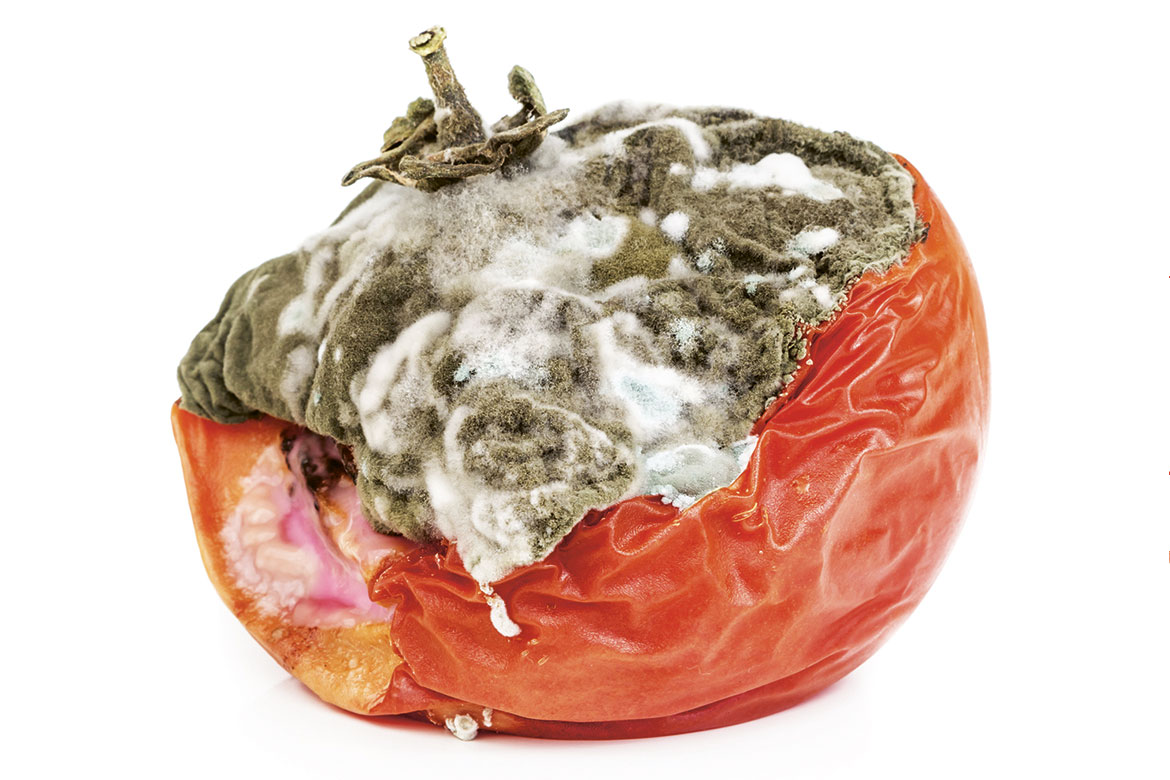Can we dispense with disgust?
What do we find delicious, and what nauseous? Researchers are investigating food to find out what we find most disgusting, and whether we can overcome our nausea.

No one would find this mouldy tomato appetising. But what about less obvious candidates for our sense of disgust? | Image: shutterstock/Martina_L.
An old, squidgy cucumber; maize salad with grubs; and a cook working with her bare hands. These images aren’t very appetising, but they encapsulate the topics that Christina Hartmann, a nutritionist at ETH Zurich, is using to measure degrees of nausea among consumers. Her questionnaire is phrased in objective, neutral terms, but the imagination of her test subjects provides the rest. Images of other people’s saliva and blood rise up in your mind’s eye, and of bugs crawling through our food. You can almost smell the putrefaction and taste the slime.
If these mental images make you cringe or feel sick, you’re reacting quite normally. “The ability to feel nausea is inborn”, says Hartmann. Disgust is one of the basic human emotions. It’s a strong, universal feeling that protects us from infection: “As a rule, we’re disgusted by things that we believe could make us sick – such as putrid, contaminated food”. Yet this nausea isn’t universal, because it’s influenced by society and culture. We learn throughout our childhood and youth to react with disgust to specific triggers, and these can change. “Frequent contact with foodstuffs that we used to find disgusting can mitigate our reactions”.
Women are quicker to feel nauseous
Hartmann and her team of researchers are using a series of studies to investigate how feelings of nausea influence our eating behaviour. This is because what we either spurn or accept on our plate has far-reaching consequences – also for the environment. Hartmann has developed two instruments for measuring disgust – one with photos, one without. Over a thousand people in Switzerland filled out her questionnaires. And a hundred people also allowed Hartmann to observe them in an experiment. They were presented, for example, with dried-out mealworms garnished with chocolate – a product that you can actually find on the market. Mealworms have been allowed as a foodstuff in Switzerland since 2017, as have crickets and locusts.

How unappetising does this seem to you? Participants in a study by ETH Zurich found the maize with the insect larvae the most disgusting, followed by the rotting tomatoes. The greying meat came last on their scale of disgust, despite being prepared with bare hands wearing rings – both potential carriers of germs. | Images: meat – Pixabay.com/yaron86; tomatoes and maize – Jeanine Ammann
Their results confirmed existing findings, according to which women are quicker to feel revulsion than men. “Because women can get pregnant, it’s advantageous for them to be more sensitive when it comes to feeling nauseous reactions”, thinks Hartmann. This sense of disgust offers them greater protection from possible sources of infection. As we grow older, these feelings of nausea diminish, but then they increase again in old age. Is it because the elderly are especially prone to illness? This isn’t clear yet, according to Hartmann. But she and her team have instead found a clear correlation between a heightened sense of disgust and either a rejection of new foodstuffs or highly selective eating behaviour in general. Disgust-sensitive people also tend to feel revulsion at gelatinous, soft textures. “Even when the foodstuffs themselves are not dangerous – such as overripe fruits and vegetables”.
Hygiene isn’t paramount
It’s notable that situations involving a lack of hygiene don’t induce strong feelings of disgust. For example, the image that came last on the scale of disgust was one of bare hands wearing rings, kneading minced meat. In this case, the health risk was probably being underestimated, says Hartmann. Her studies have shown that a sense of disgust can be highly useful to us, but can also stand in our way. Hartmann has concluded from her findings that triggers of disgust should be avoided in order for us to promote environmentally friendly behaviour. If overripe fruit and vegetables could be processed so that we didn’t see their brown patches or their wizened exterior, we could reduce food waste. And we need to prevent feelings of disgust if we are going to make palatable new foodstuffs that could serve as climate-friendly meat substitutes – such as insects.
This could start with what we call them. “‘Insects and worms’ doesn’t sound very tempting. But even when it comes to meat, we talk of steaks and cutlets, not of the species of animal they come from”. What’s more, new foodstuffs would be better accepted if they were connoted as positive or trendy and eaten communally. The best example of this is sushi bars. In our part of the world, we tend to regard raw fish as something disgusting, but as ‘sushi’ it’s become hip. Hartmann is now going to investigate disgust-sensitivity in other countries, from France to Sweden, China, South America and Australia. Apparently, fried grubs are regarded as particular delicacies at Asian street markets.
Susanne Wenger is a freelance journalist in Bern.




